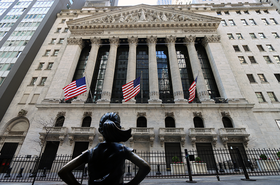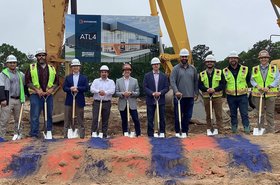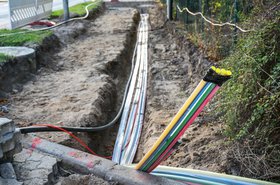There’s no way to be sure who’s right here (I am) but I’m going to make a few arguments that I hope can provide something of a guide to anyone reading this and hoping for advice on whether to double down or go short on data center REITs.
This is in response to the recent article titled “Legendary investor Jim Chanos is raising over $200 million for a 'big short' against data centers” which you can read: here [DCD's take is here, along with responses from Digital Realty, a GGV partner and Jefferies]
Here are my thoughts:
A few highlights of the current situation in hyperscale data centers
Cloud adoption by the enterprise
Cloud adoption was largely responsible for the growth we’ve been experiencing in the wholesale data center (DC) space over the last 12 years. During that time, we’ve roughly doubled hyperscale and wholesale DC capacity every three-four years.
The interesting news is that we’re still only at 20 percent or less of enterprise IT adoption potential. When you take into account generic year over year IT growth, not including net new opportunity spaces (e.g., Edge, Metaverse, Blockchain, etc.), we will double the total demand for basic IaaS services in another five to seven years. This growth when added to adoption of existing demand means that even if cloud companies quadruple capacity in the next seven years, we’ll still only be at about 40 percent of the natural cloud total addressable market.
Major trends not accounted for in the above estimates
Demand for Edge computing
While some say that Edge computing will be mostly fulfilled by the hyperscale CSPs (Cloud Service Providers) and others say that Edge will replace some of the CSP demand, my position is that demand for Edge solutions will be additive to the CSPs in large part. Edge computing is estimated to grow to between $150 and $300+ billion by 2030. If we use fairly traditional IT spend distribution models, this means that data center specific spend will likely be between $10 and $20 billion. Keep in mind, this is only associated with expected Edge demand.
Resource: IT Infrastructure Demand Requires a Rethink
Metaverse and Web3 in general
There will be considerable overlap between Edge and Metaverse in that Edge will underpin the success of Metaverse and in turn Metaverse will generate new business opportunities for Edge based infrastructure. Data protection and latency will be key requirements for much of what happens in a Metaverse environment, which is exactly what Edge was in large part designed to help with. As a market it’s hard to get past the hype right now for Metaverse, but the conservative estimates are in the $100s of billions before the end of the decade. More detail on my thoughts relative to the Edge and Metaverses can be found here “Is Metaverse the Killer App for Edge?”. Web3.0 is likely to enable additional opportunity at the Edge and in Metaverses, Smart contracts alone will create 100s of billions in revenue from new business model opportunities as well as dramatically increasing customer reach.
Will data center construction only go up from here?
As positive as I am on the long-term prospects for data center construction, specifically in the wholesale colocation space, there is likely to be a trough or two between now and 2030. However, I expect those troughs to be temporary and often specific to a given region where capacity is overbuilt. I believe this to be true because of the above and because history is a pretty good fortune teller for IT trends.
There are some who believe that the CSPs are getting so large and distributed that they won’t need the help of wholesale providers anymore. The idea is that the CSPs will have built everywhere they need to be and therefore won’t need help from wholesale providers in “new” regions. However, if the aforementioned were true, then why are ALL of the wholesalers out of space in Ashburn VA, USA, a region that’s also loaded with CSP data centers?
Other factors impacting wholesale demand and use characteristics
Pure capacity driver
Every few years we look back and think, “wow, we were so underdeveloped from a technology perspective five years ago”. This is still true today and will be true again five years from now. The opportunities for new technology-based solutions are only limited by technology pricing, ease of use and imagination. I expect that by 2030 most of us will look back on 2022 and think “we were so dark ages back then”.
Primary demand for wholesale
Cloud Service Providers
I believe that the wholesale market will continue to thrive for the foreseeable future. I believe this simply because like manufacturing, few manufacturers rely solely on their own ability to build and manage capacity. Cloud capacity demand is no different, so between surprise demand in areas where the CSPs don’t have capacity and the need to reduce CapEx risk for some capacity, demand will continue to exist.
Enterprises
I’m also a huge believer that many enterprises will look to build their own clouds or form of automated infrastructure platforms and my reasoning can be found here “Why Digital Transformation will Drive Enterprise Infrastructure ownership”. While I’m obviously a believer that some IT workloads will be held close by enterprises, I think the data center demands will likely still fall largely on wholesale colocation providers, especially for large enterprises. In other words, whether a CSP is asking for the capacity or an enterprise doesn’t matter, capacity will still be in high demand.
Finally
I guess it’s pretty clear at this point that I disagree with Jim. However, it’s entirely possible that there will be a dip that a lucky “anti-investor” could benefit from. Since I look at the market from a long-term perspective, I’m not looking to sell the dips, I’m looking to figure out how I invest more. This applies to my personal strategy and my company strategy.





